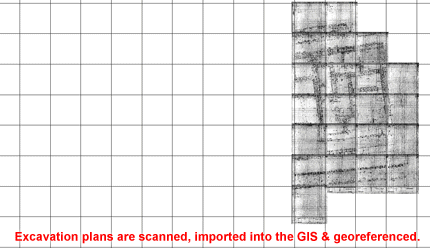Posted by Rebekah Miracle
Even though I’ve been back home from Giza for over a week now, my work with the AERA geographic information system (GIS) isn’t over– it has just shifted into a new phase.
During the excavation season, my priority was the daily digitization of new features as they came out of the ground. Over 900 new archaeological features were digitized this season, which kept me very busy! I worked closely with the excavators and our archivist to make sure that all of this season’s data was properly recorded and to provide team members with a quick, accurate, and integrated visualization of the KKT & HeG sites.
Now that the season is over, all of the new data has to be carefully checked, linked to the database of feature descriptions, and finally integrated into our existing dataset. After the data is finalized and integrated, it can be used for analysis and to make maps throughout the year – for the excavators’ reports, for publications and presentations, and to combine with the specialists’ datasets to help them place their finds in context and aid in their understanding of the site. The GIS is where all of our data ultimately comes together – archival, survey, excavation, special projects, and specialist data – and it forms an important part of the digital archive of our work on the site.
Besides working with our new excavation and survey data, this year I was also researching George Reisner’s work in the Menkaure Valley Temple in the 1930s to try to produce maps illustrating his phasing. I often found myself frustrated and wishing that his maps could have been slightly clearer about some things mentioned in the text…but I also found myself thinking how amazing it is that this work is still so useful and his archive is still being poured over 80 years later.
I can only hope that 80 years from now some researcher is sorting through the massive amount of data that we have accumulated this year and thanking (and cursing) us for it as well. Future researchers, you’re welcome (and I’m sorry)…but I hope you find the 2012 season as interesting as I did.

